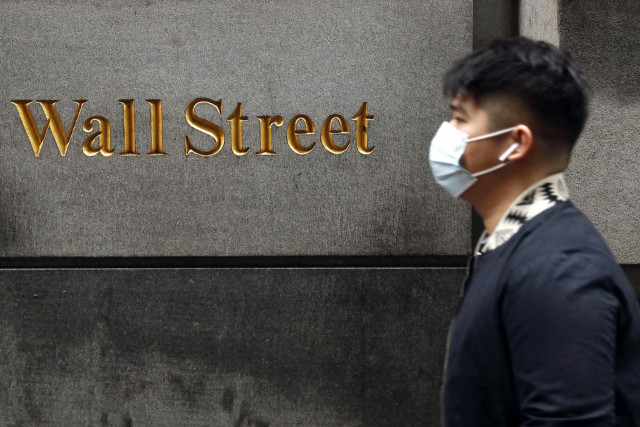How the longest bull-run in history ended in pandemic panic
Alarm wipes trillions from Asian stocks, send futures for European and US markets plunging

A Reuters image of a man wearing a mask along the Wall Street.
By daybreak in Europe, the price of crude oil had fallen by a third. The shock had turned worry about the coronavirus to full-blown panic, wiped trillions of dollars from Asian stocks and sent futures for European and US markets plunging.
“We assessed the book,” said Parrilla, 46, who runs a €300 million ($332 million) fund that is long gold and bonds and uses options to bet on just about everything but dollars and volatility falling.
“We were in a good position,” he said. “We decided which parts of the portfolio we would take profits on first.” So began what became the worst week on Wall Street since 2008, which has left Parrilla one of the few winners in the shakeout that ended the longest bull-run in US history. His Quadriga Igneo fund is up 30% for the year to date.
The wipe-out has also exposed the complacency of investors as markets marched toward record peaks in February, and the inadequacy of their protection as traditional risk correlations broke down in the rout.
“It’s these times that great fortunes are built, not bull markets,” said James Rosenberg, private client adviser at brokerage and wealth manager Baillieu Holst in Sydney.
Oil shock
The twist that sent markets already stressed by the global coronavirus outbreak into a tailspin was a plunge in the already weak oil price that followed Saudi Arabia’s move to launch a price war with Russia last weekend. By day’s end, the bonds of heavily indebted energy firms were trading many times beneath their face value, and fears of a credit crunch were growing.
It was at this point that Parrilla, who had argued for years that equities were overvalued and that the cost of betting against them in the options market was good value, was laying fresh bets. Talk on trading floors and at funds from Sydney to Singapore, Hong Kong, London and New York, was of crisis.
Wrong-way Wednesday
This is more or less what played out through the rest of the week, after what proved to be a dead-cat bounce on Tuesday.
US President Donald Trump’s announcement on Wednesday of surprise restrictions on travel from 26 European nations, his failure to mention medical measures that would be taken to combat coronavirus and disappointment over the European Central Bank’s decision not to cut interest rates didn’t just put stock indexes into freefall.
Rather than fleeing into safe havens, investors sold them to cover other losses. Bond yields, which had dived only days earlier, rose. At the same time volatility in the currency market shot higher with the squeeze in liquidity.
Black Thursday
By Thursday it had become a mad scramble for dollars and nothing else, with the Dow Jones Industrial Average suffering its worst day since 1987. After a big rebound on Friday, the index was down 10.4% for the week while the S&P 500 index had shed 8.9%.
Australian fund manager Geoff Wilson said, “To me this is a combination of ‘87 and the global financial crisis,” having spent the week between work and home revisiting every investment thesis to weed out weak stocks.
Published in The Express Tribune, March 15th, 2020.
Like Business on Facebook, follow @TribuneBiz on Twitter to stay informed and join in the conversation.



















COMMENTS
Comments are moderated and generally will be posted if they are on-topic and not abusive.
For more information, please see our Comments FAQ